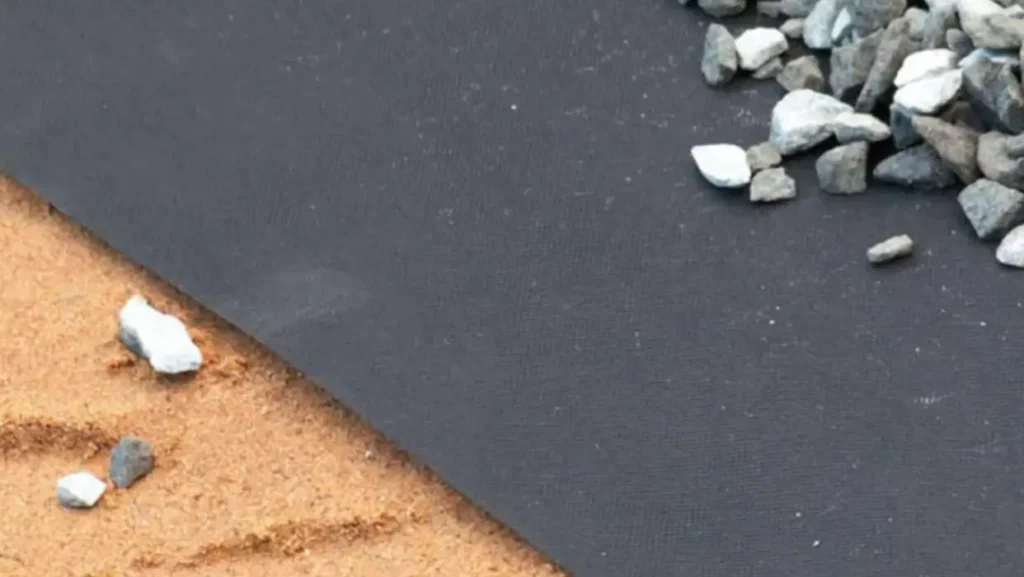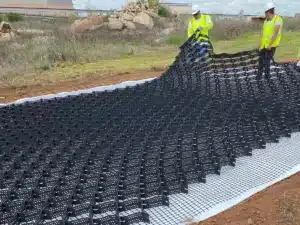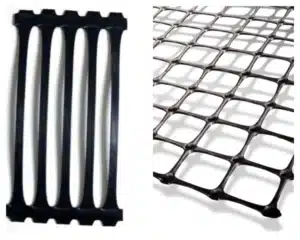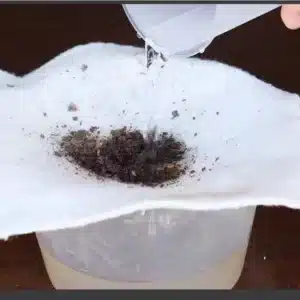Geotextile fabrics are essential materials in modern infrastructure. They help solve problems like weak soil, poor drainage, and erosion in construction and environmental engineering.
Geotextile fabric is a synthetic permeable textile used to reinforce soil, improve drainage, filter water, separate materials, and protect structures. It is typically made from polypropylene or polyester and is available in woven and non-woven forms.

These fabrics are not just industrial textiles—they’re engineering tools that protect structures, extend service life, and reduce maintenance costs. Let’s take a closer look at how they are made, how they work, and where they’re used.
What Is Geotextile Fabric?
Geotextile fabric solves a range of engineering challenges, especially in projects involving soil and water. It creates a stable foundation and prevents failure caused by soil movement or water pressure.
Geotextile fabric is a permeable material made from synthetic fibers used in geotechnical and civil engineering applications. It functions as a separation, filtration, drainage, protection, or reinforcement layer between different soil materials.
Dive Deeper: The Engineering Role of Geotextiles
The primary roles of geotextiles can be summarized into five functions:
1. Separation
Prevents the intermixing of different soil layers. This is critical in road construction where aggregate must remain separated from subgrade soil.
2. Filtration
Allows water to pass while trapping fine particles. It maintains flow without allowing soil loss, protecting drainage systems.
3. Drainage
Provides a channel for water to escape, reducing hydrostatic pressure behind retaining walls or under roads.
4. Reinforcement
Distributes loads over a larger area, increasing soil bearing capacity. It adds tensile strength to soils in embankments and retaining structures.
5. Protection
Protects other geosynthetics, such as geomembranes, from puncture or mechanical damage.
| Function | Primary Purpose | Example Applications |
|---|---|---|
| Separation | Prevents mixing of soil layers | Road bases, railway subgrades |
| Filtration | Controls movement of particles | Drainage trenches, stormwater systems |
| Drainage | Channels water | Behind retaining walls, under pavements |
| Reinforcement | Adds tensile strength to weak soils | Embankments, steep slopes |
| Protection | Guards geomembranes or pipes | Landfills, reservoirs |
What Is Geotextile Fabric Made Of?
Material choice impacts durability, strength, and chemical resistance. Engineers must match the right polymer and manufacturing process to the project.
Geotextile fabrics are made from synthetic polymers, mainly polypropylene (PP) or polyester (PET). These fibers are processed into woven or non-woven fabrics through mechanical, thermal, or chemical bonding.
Dive Deeper: Material Composition and Its Impact
Polypropylene (PP)
- Most common material
- Resistant to chemical attack
- Hydrophobic and lightweight
- Good tensile strength and UV stability
Polyester (PET)
- Higher tensile modulus
- Better creep resistance
- More suitable for high-load or long-term applications
Other additives:
- UV stabilizers: Improve outdoor lifespan
- Antioxidants: Prevent polymer degradation
- Flame retardants: For special industrial uses
| Material | Strength | UV Resistance | Chemical Resistance | Common Uses |
|---|---|---|---|---|
| Polypropylene | High | Moderate | Excellent | Drainage, separation |
| Polyester | Very High | High | Moderate | Reinforcement, filtration |
The polymer type must match the site environment. At MJY, we customize formulations based on chemical exposure, soil pH, UV exposure, and expected lifespan.
Types of Geotextiles?
Selecting the right type of geotextile is critical. Each type offers distinct mechanical, hydraulic, and installation characteristics.
There are three major types of geotextile fabrics: woven, non-woven, and knitted. Woven and non-woven are the most widely used.
Dive Deeper: Classification by Structure
Woven Geotextiles
- Manufactured by weaving polypropylene or polyester yarns
- High tensile strength and low elongation
- Ideal for reinforcement and separation
- Low permeability
Non-Woven Geotextiles
- Produced by bonding short or continuous fibers
- High water permeability
- Excellent filtration and drainage properties
- Used in roadbeds, landfills, and trench drains
Knitted Geotextiles (Less Common)
- Made by interlooping yarns
- Flexible and lightweight
- Limited use in temporary or special applications
| Type | Strength | Permeability | Best Use |
|---|---|---|---|
| Woven | High | Low | Reinforcement, separation |
| Non-Woven | Moderate | High | Filtration, drainage |
| Knitted | Low | Variable | Specialized or temporary uses |
What Is Geotextile Fabric Used For?
Geotextile fabric is used in applications requiring soil stabilization, drainage, erosion control, or environmental protection.
Geotextile fabric is widely used in civil engineering, construction, agriculture, mining, oil & gas, and water management. It plays a key role in roads, slopes, foundations, landfills, and canals.
Dive Deeper: Key Application Sectors
1. Road & Highway Construction
Used under the road base to separate soil and aggregate, reinforce soft subgrades, and reduce rutting.
2. Drainage & Filtration Systems
Placed around drainage pipes, trench systems, and under sports fields to filter water while retaining soil particles.
3. Erosion Control
Stabilizes slopes and riverbanks. Prevents topsoil loss and channel scouring in hydraulic engineering.
4. Landfill & Environmental Engineering
Protects geomembranes in lining systems and caps. Enhances durability and containment of waste materials.
5. Mining & Energy Sector
Used in haul roads, tailing dams, and well pad construction for reinforcement and drainage.
| Sector | Application |
|---|---|
| Infrastructure | Roads, railways, airports |
| Environmental | Landfills, canals, sediment control |
| Water Management | Drainage layers, reservoirs, retention ponds |
| Energy & Mining | Pads, access roads, tailing management |
How Does Geotextile Fabric Work?
Despite its simple appearance, geotextile fabric works through complex mechanical and hydraulic principles.
Geotextile fabric functions by allowing water to flow while retaining soil, distributing loads, or preventing layer mixing. Its performance depends on structure, pore size, and strength.
Dive Deeper: Scientific Principles Behind Performance
Hydraulic Function
Water passes through geotextile pores while soil is blocked. This maintains water flow in drainage systems.
Mechanical Function
Provides tensile strength to weak soils. Distributes vertical and lateral loads, reducing settlement and increasing slope stability.
Interface Friction
Acts as a friction layer between soils or between soil and structure. Enhances slope performance and load resistance.
| Function | How It Works | Critical Parameters |
|---|---|---|
| Filtration | Pores allow water, block particles | Apparent opening size (AOS) |
| Drainage | Channels water along plane | Permittivity, transmissivity |
| Reinforcement | Adds tensile strength to soil | Tensile strength, elongation |
| Separation | Prevents layer intermixing | Burst strength, thickness |
Choosing the right geotextile isn’t just about type—it’s about matching function with site-specific parameters like permeability, load, pH, and installation method.
My Opinion
In my 15 years in this industry, I’ve seen countless failures caused by using the wrong geotextile or poor installation. Cheap substitutes often lack strength, clog too fast, or degrade under UV. That’s why we always tell our clients: specify according to function, not just price.
At MJY Geosynthetics, we help clients—from government engineers to contractors in Africa and Southeast Asia—select the right fabric based on soil tests, load requirements, and expected lifespan. Our R&D team constantly tests material behavior in various site conditions.
You don’t need the most expensive product. You need the right product. Our mission is to give you geotextiles that last, perform, and protect your project investment.
FAQ
Q: How long does geotextile fabric last?
A: Over 20 years when properly buried and selected with UV-stabilized polymers.
Q: Is landscape fabric the same as geotextile?
A: No. Landscape fabric is for gardening and lacks the strength or durability for engineering use.
Q: What geotextile weight should I choose?
A: It depends on function. Lighter fabrics (100–200gsm) for drainage, heavier (300gsm+) for reinforcement.
Q: Can geotextiles be used in saltwater or chemical environments?
A: Yes, with correct polymer selection. We recommend PP or PET depending on the chemical profile.
Conclusion
Geotextile fabric is a high-performance engineering solution for soil, water, and structural challenges. It protects projects and maximizes durability.




